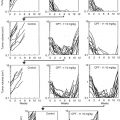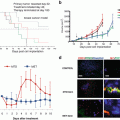© Springer International Publishing AG 2017
Robert M. Hoffman (ed.)Patient-Derived Mouse Models of Cancer Molecular and Translational Medicinehttps://doi.org/10.1007/978-3-319-57424-0_77. The First Patient-Derived Orthotopic Xenograft (PDOX) Mouse Models of Cancer: Cancer of the Colon, Pancreas, Lung, Breast, Ovary, and Mesothelioma
(1)
AntiCancer, Inc., 7917 Ostrow Street, San Diego, CA 92111, USA
(2)
Department of Surgery, University of California, San Diego, San Diego, CA, USA
Keywords
Nude micePatient tumorSurgical orthotopic implantationPrimary tumorsMetastasisPatient likeIntroduction
The introduction of the athymic nu/nu mouse (nude mouse) for the growth of human tumors in 1969 changed the paradigm of basic and applied cancer research. Human tumors could now be grown for the first time in a mouse model due to the nude mouse’s lack of a thymus which makes T cells. In 1969, Rygaard and Povlsen [1] implanted a colon cancer from a 74-year-old patient subcutaneously (s.c.) in nude mice, which grew as a well-differentiated adenocarcinoma similar to that from the donor patient. The subcutaneously growing tumors were encapsulated and did not metastasize. The original tumor was maintained over 7 years for 76 passages. The vast majority of human solid tumors, growing s.c. in the nude mouse did not metastasize. The s.c.-transplanted tumors had noninvasive growth [1, 2].
Wang et al. [3] in 1982 were among the first to implant human tumors orthotopically (literally “correct surface”) in nude mice rather than “heterotopically” (literally “different surface,” such as s.c.). Human colon cancer cell suspensions were injected within the descending part of the colon of nude mice, which resulted in occasional metastasis, a big breakthrough. Fidler’s laboratory and others have shown that the implantation of many types of human tumors in the orthotopic sites of nude mice resulted in metastasis of human tumors [4].
In order to overcome the low frequency of metastasis observed with orthotopic implantation of cell suspensions, our laboratory pioneered the patient-derived orthotopic xenograft (PDOX) nude mouse model with the technique of surgical orthotopic implantation (SOI) of intact colon cancer tissue [5]. A greater extent of metastasis was observed in PDOX models compared with orthotopically implanted cell suspensions.
The First PDOX Models (1991–1996)
We developed the first orthotopic metastatic model of patient colon cancer. Histologically intact human colon-cancer specimens derived surgically from patients were implanted orthotopically to the colon or cecum of nude mice. We observed extensive orthotopic growth in 13 of 20 cases of implanted patient colon tumors. These showed various growth patterns with subsequent regional, lymph node, and liver metastasis, as well as general abdominal carcinomatosis [5].
Colon-Cancer Local Growth and Abdominal Metastasis
An example is specimen case 1701, an infiltrating mucinous adenocarcinoma of the right colon (modified Duke’s classification C2). Two nude mice with pre-implanted Gelfoam were used for tumor implantation, two nude mice were used for tumor implantation with an internal skin flap, and two nude mice were used for direct implantation of tumor tissue to the cecum. The mice demonstrated extensive primary growth as well as abdominal-wall metastases. All mice showed visible tumor growth in the abdomen. Autopsies were performed 113–139 days after implantation [5].
Colon-Cancer Local Growth, Abdominal Metastasis, and Lymph Node Metastasis
An example is specimen case 1707, an infiltrating adenocarcinoma of the right colon, moderately differentiated (modified Duke’s classification D). Two nude mice were used for tumor and normal-surrounding-tissue co-implantation to the cecum, and two nude mice were used for tumor direct implantation to the cecum. Orthotopic primary tumor growth and abdominal metastasis occurred in three mice. A 10 × 10 mm primary tumor and 12 × 14 abdominal-wall metastasis were found at day 175 after implantation in one of the mice (tumor and normal surrounding tissue co-implanted). Lymph node metastases were noted in this animal. The histology of the original tumor and the orthotopically growing tumor both indicated adenocarcinoma [5].
Colon-Cancer General Abdominal Carcinomatosis with Extensive Peritoneal Seeding
An example is specimen case 1935, infiltrating mucinous adenocarcinoma, moderately differentiated. Extensive carcinomatosis was found with small tumors growing all over the peritoneum and abdominal organs [5].
Colon-Cancer Liver Metastasis
One nude mouse with pre-implanted Gelfoam and an orthotopically-implanted colon tumor was found to have extensive primary tumor growth and multiple liver metastasis. Histology studies on the original tumor tissue, abdominal masses, and multiple liver lesions indicated adenocarcinoma [5].
Colon-Cancer Sequential Appearance of Primary Tumor and Metastasis
Laparotomy was performed on day 26 on the nude mouse implanted with patient tumor 1594. Primary tumor growth was observed. No local or distal organ metastases were observed. The animal was returned for further observation on day 78 when the second laparotomy was performed. Primary growth was found. No liver or other distal organ metastasis was found. On day 160, the mouse was sacrificed. Primary tumor growth, local invasion, and liver metastasis were found at autopsy [5].
PDOX Model of Lung-Metastatic Colon Cancer
The human-patient colorectal tumor lung metastasis grew in the lung in 2 out of 2 animals and not in the colon in 4 out of 4 animals nor in the subcutis in 2 out of 2 animals. Histology showed a moderately- differentiated transplanted human colorectal cancer lung metastasis grown on the nude mouse lung. The resected lung metastasis from the patient and the growing lung metastasis in the mouse were both identical histologically to the patient’s original rectal tumor from which the lung metastasis occured [6]. The lung metastasis appeared to be altered to such an extent that it lost the ability to grow in the colon.
PDOX Model of Pancreatic Cancer
We developed the first orthotopic metastatic mouse model of patient pancreatic cancer. Orthotopic transplantation of histologically intact pancreatic-cancer specimens to the nude-mouse pancreas was performed. The results reflected clinical pancreatic cancer including extensive local tumor growth; extension of the locally growing human pancreatic cancer to the nude-mouse stomach and duodenum; metastases to the nude-mouse liver and regional lymph nodes; and distant metastases to the nude-mouse adrenal gland, diaphragm, and mediastinal lymph nodes. In a series of five patient cases, there was a 100% take rate. Of 17 mice transplanted, 15 had tumor growth. Immunohistochemical analysis of the antigenic phenotype of the transplanted human pancreatic tumors showed a similar pattern of expression of two human tumor-associated antigens, tumor-associated glycoprotein 72, and carcinoembryonic antigen (CEA) in the transplanted tumors, similar to the original surgical biopsy [7].
Pancreatic-Cancer Distant Metastasis to Liver
Metastases to the liver surface were seen in case 2020 [7].
Pancreatic-Cancer Very Distant Metastases
Case number 2020 involved metastasis to mesenteric lymph nodes, and case number 2008 involved distant metastases to the diaphragm, adrenal glands, mesenteric lymph nodes, and mediastinal lymph nodes and iliac lymph nodes. Metastasis to distant sites such as mediastinal lymph nodes demonstrated that actual metastasis occurred in the model, as opposed to just extension or seeding [7].
PDOX Model of Lung Cancer
We developed the first orthotopic metastatic model of patient lung cancer. Poorly differentiated large-cell squamous-cell lung cancer from a patient was transplanted orthotopically to the left lung as histologically-intact tissue directly from surgery. All five implanted mice produced locally grown tumors in an average time of 61 days. Opposite-lung metastases occurred, as well as lymph node metastases. The primary tumor and metastases faithfully maintained its large cell-squamous cell morphology. When grown s.c., this tumor grew only locally in 2 of 4 animals, and no metastases were observed [8].
Stay updated, free articles. Join our Telegram channel

Full access? Get Clinical Tree





